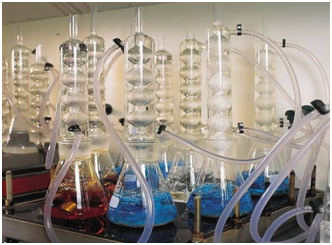IGC Practice
Om Metalab Services Pvt. Ltd. offers a variety of approaches for testing inter granular corrosion. Om Metalab Services Pvt. Ltd. carefully selects a technique for these tests that is appropriate for the steel grade and grain boundary composition. Inter metallic phases, carbides, or nitrides may precipitate in stainless steels, leading to inter granular corrosion.
Intermetallic phases are not capable of initiating an intergranular attack unless in the most oxidising solutions. A less oxidising solution is used when testing just carbides in materials with nitrides or intermetallic phases.
Services for testing Intergranular Corrosion
TECHNICAL CAPABILITIES
Om Metalab Services Pvt. Ltd. frequently carries out a number of tests in India as per the ASTM A262 specification:
- Practice A: Oxalic Acid Etch Test
(Oxalic Acid Test, ASTM A262)
This test is a quick screening method to identify stainless steel grades that are immune to intergranular attack caused by chromium carbide precipitation. The oxalic acid etch test is primarily used to accept materials, rather than reject them. It provides a visual indication of grain structure and carbide precipitation in the sample but does not quantify the material’s corrosion resistance.
2. Practice B: Streicher Test
(Ferric Sulfate-Sulfuric Acid, ASTM A262)
This method quantifies the corrosion resistance of materials by measuring weight loss. The sample is immersed in a ferric sulfate solution with 50% sulfuric acid for a period of 24 to 120 hours. It assesses the susceptibility of stainless steel and nickel alloys to intergranular corrosion caused by chromium carbide precipitation at grain boundaries.
3. C: Huey Test
(Nitric Acid, ASTM A262)
The Huey test involves boiling the sample in 65% nitric acid five times, each session lasting for 48 hours. The weight loss after each boiling cycle is recorded to determine the corrosion rate. This test is essential for evaluating whether the material has undergone proper heat treatment and for identifying chromium-depleted areas and intermetallic precipitations such as the sigma phase. The Huey test is critical for materials exposed to highly oxidizing environments, like nitric acid.
4. Practice E: Strauss Test
(Copper Sulfate-Sulfuric Acid, ASTM A262)
This test assesses the material’s susceptibility to intergranular corrosion caused by the precipitation of chromium-rich carbides. After exposing the sample to boiling copper sulfate and 16% sulfuric acid, the sample is bent through 180 degrees and visually inspected for signs of cracking or corrosion. This test is particularly useful for solid stainless steel materials.
5. Practice F
(Copper Sulfate-Sulfuric Acid, ASTM A262)
This test is similar to Practice B, but it uses 50% sulfuric acid and includes a weight loss measurement to determine the material’s resistance to intergranular corrosion in its “as received” condition. This test provides a measurable comparison of the material’s performance against known standards
Why Choose Om Metalab for IGC Testing?
With state-of-the-art testing facilities and experienced metallurgical experts, Om Metalab Services Pvt. Ltd. provides comprehensive IGC testing in accordance with international standards like ASTM and ISO. We are committed to delivering precise and reliable results, helping our clients ensure the integrity and longevity of their materials.
Standard we tested to
Sr. No. | Discipline: IGC Practice | Test Methods |
1 | Intergranular Corrosion Test (Practice A) | ASTM A262: 2021 |
2 | Intergranular Corrosion Test (Practice E) | ASTM A262: 2021 |
- Practice A (Oxalic Acid Etch) of the Oxalic Acid Test, ASTM A262
The oxalic acid etch test is a quick way to check samples of some stainless steel grades that are essentially immune to the intergranular attack caused by chromium carbide participants. The test is used to accept a material rather than to reject it. - Practice B (Streicher Test) of the Ferric Sulfate-Sulfuric Acid, ASTM A262 standard
This test gives a quantifiable measurement of the relative effectiveness of the material studied and is based on weight loss determinations. The process involves boiling a sample in ferric sulphate, which contains 50% sulfuric acid, for 24 to 120 hours. This method analyses the resistance of nickel alloys and stainless steel to intergranular harm brought on by the precipitation of chromium carbides at grain boundaries.
- Practice C of the Huey Test for Nitric Acid, ASTM A262
The samples are immersed in a 65 percent nitric acid solution and boiled five times for a total of 48 hours each. The reduction in specimen weight during each boiling interval is used to calculate the corrosion rate. When the results are appropriately evaluated, they can show whether or not the steel has been heat-treated adequately. The customer must state the highest allowed corrosion rate and, if applicable, supply information on raising heat treatment.
The Huey test environment, which is highly oxidising, is solely used to determine whether the material has been heat treated properly. This test is appropriate for locating areas in the material that are low in chromium as well as intermetallic precipitations like the sigma phase. Materials that come into touch with severely oxidising chemicals, such as nitric acid, are also subjected to the Huey test. The efficiency of stabilising components and carbon content decreases in reducing susceptibility to intergranular attack in chromium-nickel stainless steels may also be evaluated using this approach.
- Practice E (Strauss Test) of ASTM A262 for copper, copper sulphate, and 16% sulfuric acid
This approach is used to assess the solid stainless steel’s sensitivity to intergranular attack brought on by the precipitation of carbides rich in chromium. The specimen is bent through 180 degrees and over a diameter that is equivalent to the thickness of the specimen being bent after being exposed to the solution boil. Based on a visual inspection of the bent specimen, this test is conducted.
- Practice F of ASTM A262 for copper, copper sulphate, and 50% sulfuric acid
The weight loss measurement used in this test gives a measurable indication of how well the examined material performed in comparison to other materials. It assesses the stainless steel’s vulnerability to intergranular assault in “as received” condition.

